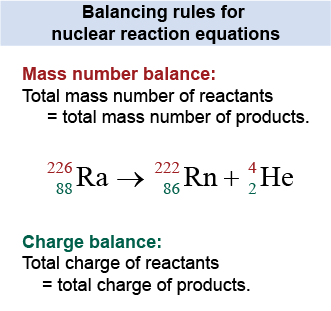|
 A nuclear reaction is any process that changes the nucleus of an atom. Nuclear reactions may change one element into another or change one isotope into a different isotope of the same element. Because nuclear reactions involve the strong nuclear force, the energy is typically thousands of times greater for nuclear reactions compared to chemical reactions. Chemical reactions change the way atoms of different elements are combined into compounds but do not change the nuclei of any atom. Instead, chemical reactions rearrange shared electrons to reconnect atoms. The energy in a chemical reaction is far too low to change atoms of one element into atoms of a different element, nor do chemical reactions change isotopes into different isotopes.
A nuclear reaction is any process that changes the nucleus of an atom. Nuclear reactions may change one element into another or change one isotope into a different isotope of the same element. Because nuclear reactions involve the strong nuclear force, the energy is typically thousands of times greater for nuclear reactions compared to chemical reactions. Chemical reactions change the way atoms of different elements are combined into compounds but do not change the nuclei of any atom. Instead, chemical reactions rearrange shared electrons to reconnect atoms. The energy in a chemical reaction is far too low to change atoms of one element into atoms of a different element, nor do chemical reactions change isotopes into different isotopes. 
|
Writing balanced nuclear reaction equations
|
Nuclear reactions can change an element into a different element. This change means that the number of protons and neutrons of the element will be altered. Nuclear reactions are represented by nuclear reaction equations, just as chemical reactions are represented by chemical reaction equations. Every nuclear reaction equation has two parts: reactants and products. Consider the nuclear reaction that produces carbon-14 in the atmosphere. In this nuclear reaction, a neutron interacts with nitrogen-14 to produce carbon-14 and a proton. The equation for this reaction is | (27.3) | |
|
 The equation is just a representation of the reaction and to be correct it must correctly represent the physics of the reaction. First, the reaction equation must show mass balance by having the mass numbers equal on both sides of the equation. This means that the total number of protons plus neutrons does not change. Second, the total charge before the reaction must equal the total charge afterward, which is the basic law of charge conservation. These two fundamental rules for balancing nuclear reaction equations can be used to determine an unknown element in a reaction.
The equation is just a representation of the reaction and to be correct it must correctly represent the physics of the reaction. First, the reaction equation must show mass balance by having the mass numbers equal on both sides of the equation. This means that the total number of protons plus neutrons does not change. Second, the total charge before the reaction must equal the total charge afterward, which is the basic law of charge conservation. These two fundamental rules for balancing nuclear reaction equations can be used to determine an unknown element in a reaction. 
|
Consider the incomplete reaction equation To find the unknown element X we start by applying the charge conservation (proton balance) rule: 92 = Z + 38 ⇒ Z = 54 From the periodic table we see that the element with atomic number 54 is xenon. Next we identify the xenon isotope by applying the mass balance rule: 1 + 235 = A + 94 + 1 + 1 ⇒ A = 140 So the unknown nucleus is xenon-140 or . The complete reaction is 
|
In a 1917 experiment, Rutherford bombarded a nitrogen-14 nucleus with a helium-4 nucleus (an alpha particle), causing the nitrogen atom to change to a different element and producing a proton. What was the resulting isotope of his reaction?
 |
Answer: The resulting isotope is oxygen-17.
Asked: element that is the product of the nuclear reaction
Given: particles before the reaction: helium-4 and nitrogen-14;
atomic mass numbers before the reaction: helium has A = 4 and nitrogen has A = 14;
particles after the reaction: proton and an unknown isotope
Relationships: A = Z + N
Solution: First, determine the atomic mass number of all the particles. Two are already given explicitly (helium-4 and nitrogen-14). The proton’s atomic mass number is A = 1. Look up the atomic number for all the particles: For He, Z = 2; for N, Z = 7; and for the proton, Z = 1. Write down the nuclear reaction equation: | |
The total number of nucleons, A, must remain the same, so the mystery isotope has A = 17. The total charge must be the same on both sides of the equation, so the mystery isotope must have Z = 8. Look up Z = 8 on the periodic table and we see that the mystery element is oxygen, so the isotope is oxygen-17. 
|

